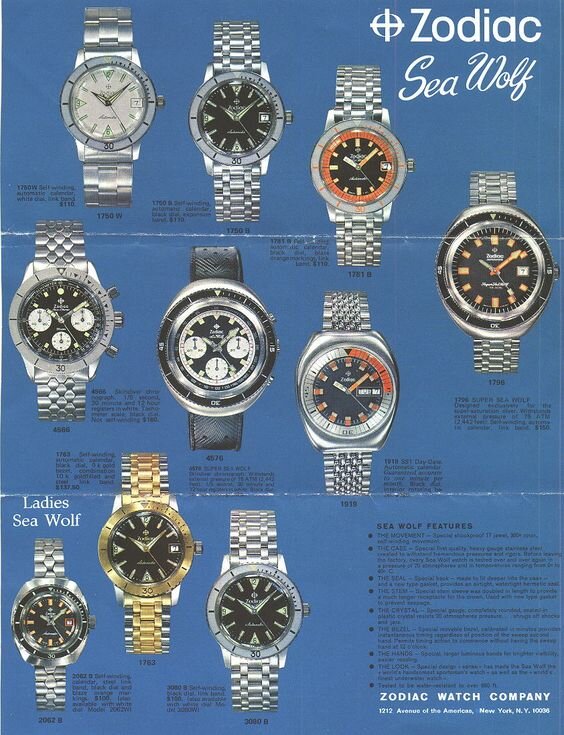Let’s Talk History of the Zodiac Sea Wolf
The Zodiac Sea Wolf is a legendary dive watch, and as it reaches the radar of more and more collectors, it deserves a deep dive into its legacy, design and prowess.
The Zodiac Sea Wolf is something of an underdog in the history of iconic dive watches. First unveiled at Baselworld in 1953 at the same time as the Blancpain Fifty Fathoms, it actually predates the release of the Rolex Submariner. Despite arguably the first rotating bezel on a diver and a deeper depth rating than even the Fifty Fathoms, its prices are nowhere near its fellow divers of the era.
While their value has risen significantly in recent years as the aforementioned early divers become more and more unattainable for the everyday collector, they are still available with some keen searching and have a glorious array of iterations and design choices with piles of charisma — making them a great rabbit hole for collectors outside the echelons of vintage Submariners. Today, we’re here to tell you some stuff about the Zodiac Sea Wolf you might not know yet.
A gilt dial Zodiac Sea Wolf, the reference sold at Vietnam PX outposts.
Early history and military provenance
Zodiac has always been a brand with a rich history of innovation and experimentation. Whether it was their ‘flat pocket watch’ of the 1920s, or their automatic ‘sports watch’ of the 1930s, Zodiac has a long list of impressive firsts. That list doesn’t stop with their introduction of the Seawolf. Early Seawolf models featured a bidirectional countdown bezel, and often Arabic numerals on the dial. However, it’s important to note that the Seawolf hasn’t changed much in its design for many decades. For instance, comparing a 1950s Seawolf to its modern counterpart — other than a difference in size and construction, the same design language is prevalent.
It’s important to note that its functionality was one of the main thoughts behind the Seawolf. This functionality translated perfectly over to the military, and it became a choice timepiece for those serving in the Vietnam War. Zodiac Sea Wolf watches were readily available overseas at PX (Post Exchange) outposts — a retail space for those in the service.
There are countless anecdotes by those who trusted their Zodiac Seawolf watches in the field, as the watches rarely failed. This helped earn the Seawolf a solid reputation, being a watch that was equally as reliable as it was stylish. However, the Seawolf’s relationship with the military didn’t end in Vietnam. During the 1970s, Zodiac introduced the Super Sea Wolf — a watch with an updated case that could withstand even deeper waters and harsher elements. This watch was soon adopted by the U.S. Navy SEALs for its durability and functionality.
Considering their illustrious history, it’s peculiar why these vintage watches aren’t traded for more. If we were talking about a Rolex military-spec Submariner, the price is more than you could imagine — but a Seawolf that saw time in Vietnam will still only run you just over a grand.
Zodiac Sea Wolf ref. 1781 B
Bright design in a utilitarian era
The design of the Seawolf changed surprisingly little since its introduction. This is a trend we see with many other iconic watches of top-name brands, whether it’s a Cartier Tank or Rolex Sub — icons are icons for a reason — their design is instantly recognizable. However, the design of the Seawolf hardly stems from an area of fashion or prowess, more from an area of functionality and reliability in an era of utilitarianism.
For a moment, imagine it’s the early 1950s. Some of the industry’s most recognizable watches are merely in their infancy, or not even conceptualized yet. Watches are an absolute necessity for almost everyone on a daily basis — they're tools. However, the market is flooded with small, dainty, precious metal, delicate watches that are assuredly dress watches by today’s standard. What will the divers, the pilots, the soldiers, and mere men of action wear when they need a reliable time gauge whilst bearing the elements?
Zodiac, being an innovative Swiss house, noticed the market demand for such a timepiece, and by seizing the opportunity they became one of the first to offer a countdown rotating bezel dive watch built to withstand some of the harshest climates. Not only is this a shock of sorts to the consumer, but it’s a first for the industry, and the birth of an icon — one that would dictate the brand’s identity for decades to come. But still, the Sea Wolf needed to stand out, which is where the model’s now infamous wild colorways came into play. In a day of black, steel, and grey dive watches, the Sea Wolf opted instead to offer vibrant blues, oranges, and pinks.
Early 1960s Zodiac ad featuring bright colorways and J.B. Champion bracelets
Bracelets of champions
An interesting aspect I often see neglected in stories of the Sea Wolf is their bracelets — this might just be because I’m a bracelet guy, but the bracelets of Zodiac Sea Wolf models are unsung heroes of bracelet design that last as coveted artifacts of midcentury bracelet design.
Zodiac partnered with legendary bracelet manufacturer J.B. Champion in the early 1950s to put their range of dive watches onto reliable and beautiful bracelets. Nearly every Sea Wolf model originally came on one of around 20 J.B. Champion bracelet designs through the years, many of which never appeared on any other watch. While some Sea Wolf models kept dive-friendly Oyster-style stretch bracelets, examples like the 5-link bullet bracelet and diamond-link bracelets are as rare as they come and remain beautiful, robust designs.
While vintage Rolex bracelets are somewhat notorious for their tinny jangle on older Oyster and Jubilee bracelets, the J.B. Champion bracelets used on Sea Wolf models are comparatively surprisingly sturdy — some using solid links decades before Rolex introduced their own. Many rival some of the far more expensive Gay Freres bracelets of the day, like the early J.B. Champion beads of rice and the infamous stretch band.
Finding Zodiac Sea Wolf models on their correct, original bracelets nowadays is becoming much tougher than in previous years, and thus their asking prices push above non-bracelet examples, but the interesting design and timeless style of the bracelets they used make the premium more than worthwhile.
A modern Zodiac Super Sea Wolf. Source: Zodiac Watches
The Zodiac Sea Wolf today
Zodiac was, for most intents and purposes, a casualty of the Quartz Crisis that erased countless legacy brand names from the watch market. They experienced some inklings of revival more than once in the 1990s, but were ultimately only fully resurrected in the 2010s, having been purchased by the Fossil group.
The Sea Wolf revival, now ostensibly the Super Sea Wolf, is pure and true to the original icon — straight down to the wild and unexpected colorways of many models. While the watches have been modernized from a 35mm case to 40mm, they retain their flourished of color paired with a focus on functionality. Even today, the Zodiac Sea Wolf is intended for diving and fully capable of doing so. Will the modern Zodiac consumer be diving with a Sea Wolf? Probably not. But as watch journalists have been saying since the early days, there’s something satisfying about wearing an icon and knowing it can still do what it was originally supposed to.
If you’d like to see more deeper dives like this about a watch, brand or topic you love, tell us! We’d love to hear from you.






